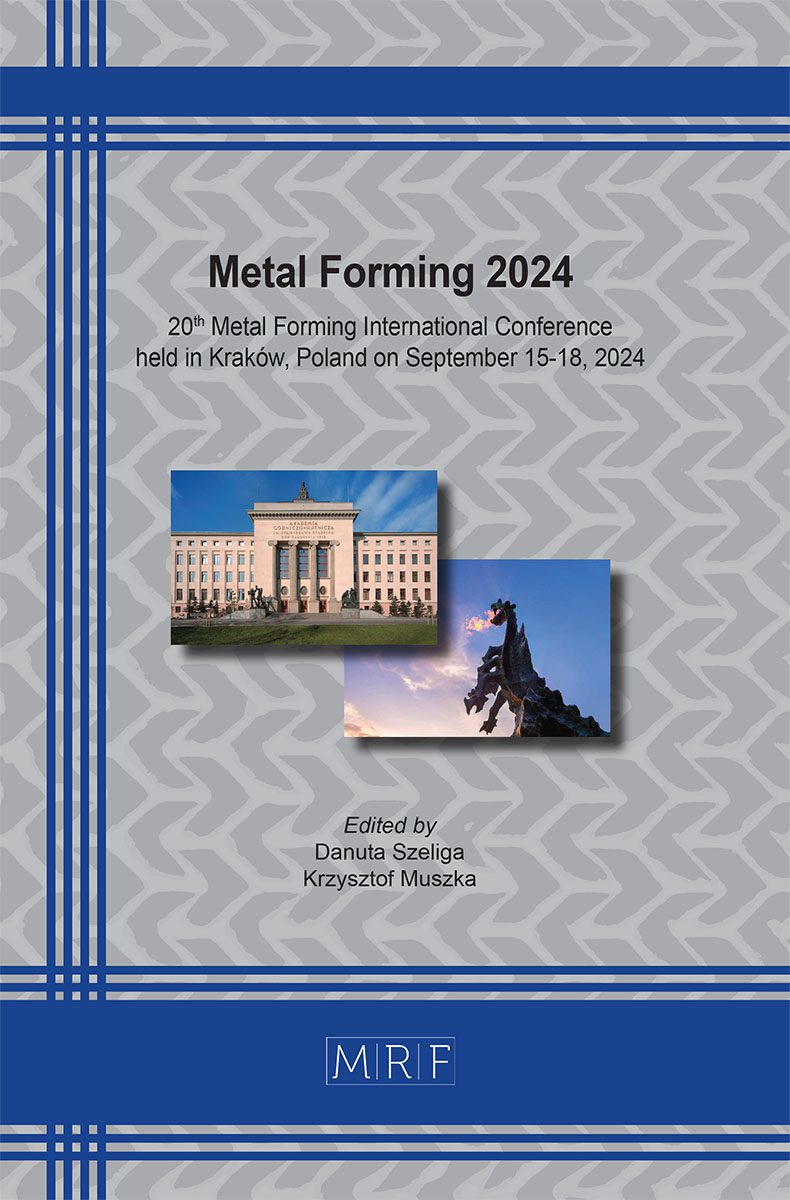–
FEM study of process parameters in a novel superplastic forming of titanium alloy Ti-6Al-4V
LIU Jun, PARAMESWARAN Elangovan, YAKUSHINA Evgenia, ZUELLI Nicola, MILLIKEN David M., HUMPHREYS Nick, GILL Les, GREENOUGH Christopher
download PDFAbstract. A novel hybrid forming process involving the use of hot drawing along with superplastic forming (SPF) is studied here. The hot drawing stage helps in enhancing the formability and in fast deforming the sheet metal into a hollow shape with desired amount of material draw-in. During the subsequent SPF stage, gas pressure was applied onto the pre-formed part to complete the forming process at a targeted strain rate. With the hybrid process, titanium alloy Ti-6Al-4V sheets have been successfully formed in lab-scaled conditions at 800°C in 16 min. In this paper, finite element modelling (FEM) was used to demonstrate the effects of each stage (hot drawing and SPF) during the process. A plasticity model based on tensile test data was adopted as a material model for simulation. The pressure cycle which was predicted from the simulation has been used in the process to maintain the sheet forming at an average strain rate (e.g. 10-3 and 5×10-4 s-1). Material draw-in and thickness distribution were used to compare and optimise the process parameters. The simulations have shown the capability of the model to be used for the hybrid superplastic forming process. The influences of varying process parameters, such as punch geometry, blank size, blank-holder force, friction coefficient and pressure cycle, were investigated by the simulations. It was found that the punch geometry and blank size played significant roles on the thickness uniformity of the final part, from which an optimised hot-drawing system that could lead to minimum thinning has been designed by FEM method.
Keywords
Titanium, Superplastic Forming, Hot Drawing, Strain Rate
Published online 9/15/2024, 9 pages
Copyright © 2024 by the author(s)
Published under license by Materials Research Forum LLC., Millersville PA, USA
Citation: LIU Jun, PARAMESWARAN Elangovan, YAKUSHINA Evgenia, ZUELLI Nicola, MILLIKEN David M., HUMPHREYS Nick, GILL Les, GREENOUGH Christopher, FEM study of process parameters in a novel superplastic forming of titanium alloy Ti-6Al-4V, Materials Research Proceedings, Vol. 44, pp 209-217, 2024
DOI: https://doi.org/10.21741/9781644903254-23
The article was published as article 23 of the book Metal Forming 2024
![]() Content from this work may be used under the terms of the Creative Commons Attribution 3.0 license. Any further distribution of this work must maintain attribution to the author(s) and the title of the work, journal citation and DOI.
Content from this work may be used under the terms of the Creative Commons Attribution 3.0 license. Any further distribution of this work must maintain attribution to the author(s) and the title of the work, journal citation and DOI.
References
[1] S.P. Akula, M. Ojha, K.L. Rao, A.K. Gupta, A review on superplastic forming of Ti-6Al-4V and other titanium alloys, Mater. Today Commun. 34 (2023) 105343.
[2] D. Lee, W.A. Backofen, Superplasticity in Some Titanium and Zirconium Alloys, Trans. Metall. Soc. AIME 239 (1967) 1034-1040.
[3] A.J. Barnes, Superplastic Forming 40 Years and Still Growing, J. Mater. Eng. Perform. 16 (2007) 440-454. https://doi.org/10.1007/s11665-007-9076-5
[4] T.G. Nieh, J. Wadsworth, O.D. Sherby, Superplasticity in Metals and Ceramics, Cambridge University Press, Cambridge, 1997.
[5] J. Liu, M.-J. Tan, Y. Aue-u-lan, M. Guo, S. Castagne, B.-W. Chua, Superplastic-like forming of Ti-6Al-4V alloy, Int. J. Adv. Manuf. Technol. 69 (2013) 1097-1104. https://doi.org/10.1007/s00170-013-5101-z
[6] J. Liu, J. Edberg, M.J. Tan, L.E. Lindgren, S. Castagne, A.E.W. Jarfors, Finite element modelling of superplastic-like forming using a dislocation density-based model for AA5083, Modell. Simul. Mater. Sci. Eng. 21 (2013) 025006. https://dx.doi.org/10.1088/0965-0393/21/2/025006
[7] ASTM E2448 Standard Test Method for Determining the Superplastic Properties of Metallic Sheet Materials, ASTM International (2022).












